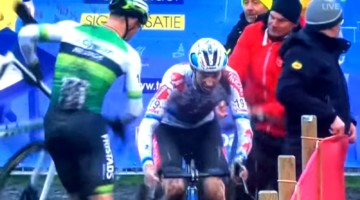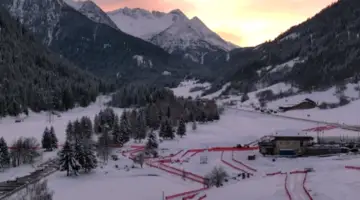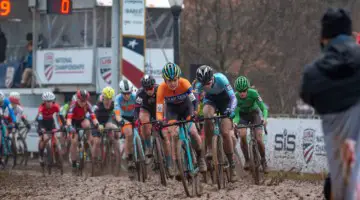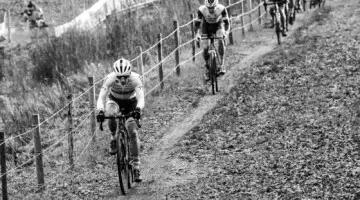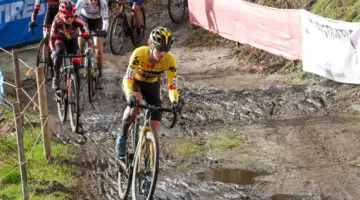Masters racer and regular contributor Lee Waldman has some thoughts to air out about the 2010 Cyclocross National Championships. The opinions expressed belong to Lee and do not necessarily reflect the opinions of Cyclocross Magazine. But we at CXM do hope that they’ll fuel a constructive debate…drop your own comments below.
If you missed Lee’s last columns on his personal race experience in Bend, or his reflections on this year’s new cyclocross rules, go back and check ’em out!
by Lee Waldman
I’m wondering if it isn’t time to revisit the model that we use in the US for Nationals. Bend was an excellent event, don’t misinterpret. I love the town, loved the course and even “loved” the weather, in the sense that it offered a challenge that we haven’t seen here in Colorado this year. But anything can be improved upon, and unless we continually examine what we’re doing, we run the risk of growing stale.
The course for this year’s Championship was an improvement over last year’s. The technical section after the pit plus the added length in the grass helped. It also was much easier on the officials – riders still got lapped, but at least it didn’t happen so early-on in the race.
Having come from a region that was “blessed” with dry weather this past season, the snow presented a challenge that I hadn’t seen since, well, since Bend last December. In the past I’ve struggled with slick and icy conditions such as those that I found at 8:30 on Thursday morning. Two years ago I would have been overcome with anxiety and literally crept around the course, white-knuckling each descent and crawling around the corners.
Having worked on my cornering during the season, I was a lot more confident in my technique this time around. Choosing to ride the “B” race on Wednesday gave me some familiarity with the course and that helped as well. I might have had too much fun on Wednesday, though. I lined up for a next-to-last-row start, and so I raced with the goal of catching and passing as many “youngsters” as possible. And I was pretty successful, moving into the top 40 for a while until a half-dozen falls moved me back into the 50s. Still, I had fun – so much fun, in fact, that after the race a complete stranger approached me and commented on the ear-to-ear grin I wore through the entire event.
8:30 the next morning came way, WAY too early, and I learned the hard way that at 60 years old, it’s tough to recover from a hard effort in less than 18 hours. The legs just weren’t there, and after getting a great start, I was ignominiously dropped by riders who hadn’t raced the day before and were fresher than I was.
But I digress. The course conditions: Snow, ice, monster puddles. They transformed what might have been a 9-meter-wide ’cross course into a good deal of singletrack. The icy section through the woods was treacherous and left me with a severely sprained thumb, but it is ’cross, and we need to take the courses as we find them. I love riding in the snow and wouldn’t want it removed because then it’s road racing. I’m wondering, though, if there was anything that the promoters could have done to widen out the course so the entire width could have been ridden, even with the snow? After watching the last several races in Europe, maybe not. It’s just a question.
I know many of you are reading this and wondering: Who is this guy anyway? Does he have the determination, skill and desire to race ’cross? Those of you who have raced with me know that I’ll be out there battling no matter the conditions and the weather, and I’ll be doing it with a grin. That said, I still believe there are some things that could have been changed to make the racing more equitable for all categories.
One thing did bother me, though. On Wednesday morning I went out early to pre-ride for the B race. I expected some mud, some water and some frozen ruts, and I found them. The course was challenging, but fun. Then I came off of the first grassy section by the brewery and turned left onto a 4-inch-thick sheet of ice. Couldn’t even walk on it! Turned around, went back to the hotel and, with visions of broken ribs, elbows and collar bones, seriously considered bagging the race. An hour later, after delaying the women’s starts, the offending section of the course had been taken out – it took multiple complaints from riders, though. Kudos for listening. Why didn’t they see the problem themselves?
That said, the racing was great, the course challenging, and the best riders, as they always do, won the stars and stripes jerseys. What I’d really like to talk about is how we organize our cyclocross National Championships. Why is it that in every other cycling discipline Elites, Masters and Juniors have their own National Championship races separated by date and venue, but in cyclocross we squeeze them all together into one consolidated five-day period? Look at the USA Cycling schedule. In track, Juniors, Masters and Elites race their Championships in different venues and at different times. Same with the road. Not in ’cross.
There are some benefits. Parents who also race can compete at the same time and place as their children. Since the Elite race takes place later in the week, if time isn’t an issue, it’s easy to stay and watch. The downside is that the scheduling leaves me feeling that the non-Elite categories, with the exception of the older Juniors and the U-23s, are all afterthoughts. They get the worst start times. Both years in Bend, we were breaking the ice off of frozen courses and riding off the snow that makes the course look more like single track.
I hesitate to write this because I know I come across as a whiner. Believe me, I’m not. I rode the race and loved all of the physical and mental challenges it presented. It took power, strength and focus to ride well. That, in my opinion, is what separates cyclocross from other cycling disciplines. I’m presenting this more as a way to prompt discussion and critical thought.
Why can’t USAC follow the same process for selecting venues and dates for cyclocross nationals than they do for those other disciplines? Accept bids separately for Junior Nationals, Masters Nationals and Elite Nationals. Make sure that the dates are late enough in the year, especially for those riders with aspirations of racing in Europe so that they can still fulfill those dreams.
Schedule Masters Nationals at a time that doesn’t conflict with the holidays but insures that most riders who want to attend will be able to. Mid-November might even work. Some might argue that holding a championship race that early in the year doesn’t fit in with tradition. My answer: is tradition truly that important? Shouldn’t it be more of a priority to establish a system that works for the majority of the riders? Just because we’ve always done it a certain way, does that mean that it’s the right way? Spreading out the racing in that manner would ease the burden on families and still respect the needs of the Elite Juniors and Seniors to prepare for racing overseas later in the year.
It might be burdensome to a city to host all three of these events at separate times. Accept bids from separate venues for each championship. It works on the road and on the track. Why wouldn’t it work in ’cross? If there is a city that would like to host multiple championships, then by all means give them the chance. Do something though because the current system, although it works, isn’t the best.
Here’s what making these changes would do: First of all, it effectively shortens the extended periods of time that any one group has to be away from home. This year’s races in Bend took place over five days. If you were an older Masters racer like me, or if you were the parent of a younger Junior, you potentially had to miss an entire week of work or school to race. One day at least to travel, one day to preview the course, one day to race. Then the choice was to rush home for the end of the week or spend more time and money in Bend to watch the weekend’s Elite races. If separate championships were held, then the time could be compressed, which might be easier on many people.
Separating championships would eliminate the ridiculous times that many of the categories are currently forced to race. Why should masters racers who pump so much money into the sport and juniors whose families do the same be relegated to the least desirable race times? It’s dark and cold when we race. The courses are usually the least rideable and the most challenging for younger and older riders alike. Again, I’m not complaining about challenging courses. It is cyclocross after all! But if there’s a better way why not examine it? This is the that put the most money back into the sport and into the venues where the championships are held yet they are treated in many ways as second class citizens.
Separating races would also allow for more time to pre-ride courses during each race day without forcing riders to risk disqualification if they sneak on. This also would make the racing fairer and safer by allowing riders to ride courses at close-to-race speeds during training. With so many racers wanting to look at courses in the limited time available to them, it’s more difficult every year to get an accurate look at a course without racing on it.
There are, of course, downsides to separation. Each city would make less money. Riders wouldn’t have the opportunity to watch the Elite races without spending more time and money to travel. Companies that wanted to display their products at races would have to choose: split their resources, or pass on some events. It’s certainly not a perfect solution, but it does work in the other disciplines. The other problem might be that there just aren’t that many cities willing to bid on ’cross championships – but we’ll never know unless we try.
My last column on rule changes generated a lot of discussion. I’m sure this one will as well. Remember, discourse and discussion have a long history in this country, and they can only help to grow our sport. I appreciate and value differing opinions and mine is only one – and certainly not the final one. Dispute my ideas at will, but please direct your comments at my ideas and not at me, if you please.
Now go ride your bikes!






















